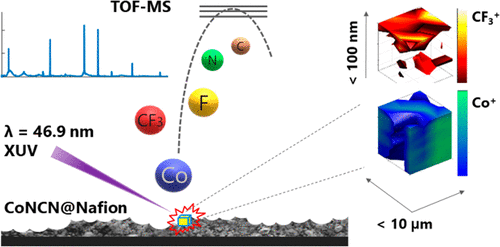当前位置:
X-MOL 学术
›
Anal. Chem.
›
论文详情
Our official English website, www.x-mol.net, welcomes your feedback! (Note: you will need to create a separate account there.)
Depth-Profiling Microanalysis of CoNCN Water-Oxidation Catalyst Using a λ = 46.9 nm Plasma Laser for Nano-Ionization Mass Spectrometry
Analytical Chemistry ( IF 7.4 ) Pub Date : 2018-07-02 00:00:00 , DOI: 10.1021/acs.analchem.8b01740 Rafael Müller 1 , Ilya Kuznetsov 2 , Yunieski Arbelo 3 , Matthias Trottmann , Carmen S. Menoni 3 , Jorge J. Rocca 2 , Greta R. Patzke 1 , Davide Bleiner 1, 3
Analytical Chemistry ( IF 7.4 ) Pub Date : 2018-07-02 00:00:00 , DOI: 10.1021/acs.analchem.8b01740 Rafael Müller 1 , Ilya Kuznetsov 2 , Yunieski Arbelo 3 , Matthias Trottmann , Carmen S. Menoni 3 , Jorge J. Rocca 2 , Greta R. Patzke 1 , Davide Bleiner 1, 3
Affiliation

|
Nanoscale depth profiling analysis of a CoNCN-coated electrode for water oxidation catalysis was carried out using table-top extreme ultraviolet (XUV) laser ablation time-of-flight mass spectrometry. The self-developed laser operates at λ = 46.9 nm and represents factor of 4 reduction in wavelength with respect to the 193 nm excimer laser. The reduction of the wavelength is an alternative approach to the reduction of the pulse duration, to enhance the ablation characteristics and obtain smaller quasi-nondestructive ablation pits. Such a XUV-laser ablation method allowed distinguishing different composite components of the catalyst-Nafion blend, used to modify a screen-printed carbon electrode surface. Chemical information was extracted by fragment assignment and relative amplitude analysis of the mass spectrometry peaks. Pure Nafion and the exposed carbon substrate were compared as references. Material specific fragments were clearly identified by the detected nonoverlapping mass-to-charge peaks of Nafion and CoNCN. Three dimensional mapping of relevant mass peak amplitudes was used to determine the lateral distribution and to generate depth profiles from consecutive laser pulses. Evaluating the profiles of pristine electrodes gave insight into fragmentation behavior of the catalyst in a functional ionomer matrix and comparison of post-catalytic electrodes revealed spots of thin localized Co residues.
中文翻译:

使用λ= 46.9 nm等离子激光进行纳米电离质谱分析CoNCN氧化催化剂的深度分析微观分析
使用台式极紫外(XUV)激光烧蚀飞行时间质谱仪对CoNCN涂层电极进行水氧化催化的纳米级深度分析进行了分析。自行开发的激光器在λ= 46.9 nm处工作,相对于193 nm准分子激光器,其波长减少了4倍。减小波长是减小脉冲持续时间的替代方法,以增强消融特性并获得较小的准无损消融坑。这种XUV激光烧蚀方法可以区分催化剂-Nafion共混物的不同复合成分,这些成分用于修饰丝网印刷的碳电极表面。通过碎片分配和质谱峰的相对幅度分析来提取化学信息。比较纯Nafion和暴露的碳基材作为参考。通过检测到的Nafion和CoNCN的非重叠质荷峰可以清楚地识别出特定于材料的碎片。相关质量峰幅度的三维映射用于确定横向分布并从连续的激光脉冲生成深度轮廓。评估原始电极的轮廓可以深入了解功能性离聚物基质中催化剂的裂解行为,而对催化后电极的比较则发现了局部Co残留物稀薄的斑点。相关质量峰幅度的三维映射用于确定横向分布并从连续的激光脉冲生成深度轮廓。评估原始电极的轮廓可以深入了解功能性离聚物基质中催化剂的裂解行为,而对催化后电极的比较则发现了局部Co残留物稀薄的斑点。相关质量峰幅度的三维映射用于确定横向分布并从连续的激光脉冲生成深度轮廓。评估原始电极的轮廓可以深入了解功能性离聚物基质中催化剂的裂解行为,而对催化后电极的比较则发现了局部Co残留物稀薄的斑点。
更新日期:2018-07-02
中文翻译:

使用λ= 46.9 nm等离子激光进行纳米电离质谱分析CoNCN氧化催化剂的深度分析微观分析
使用台式极紫外(XUV)激光烧蚀飞行时间质谱仪对CoNCN涂层电极进行水氧化催化的纳米级深度分析进行了分析。自行开发的激光器在λ= 46.9 nm处工作,相对于193 nm准分子激光器,其波长减少了4倍。减小波长是减小脉冲持续时间的替代方法,以增强消融特性并获得较小的准无损消融坑。这种XUV激光烧蚀方法可以区分催化剂-Nafion共混物的不同复合成分,这些成分用于修饰丝网印刷的碳电极表面。通过碎片分配和质谱峰的相对幅度分析来提取化学信息。比较纯Nafion和暴露的碳基材作为参考。通过检测到的Nafion和CoNCN的非重叠质荷峰可以清楚地识别出特定于材料的碎片。相关质量峰幅度的三维映射用于确定横向分布并从连续的激光脉冲生成深度轮廓。评估原始电极的轮廓可以深入了解功能性离聚物基质中催化剂的裂解行为,而对催化后电极的比较则发现了局部Co残留物稀薄的斑点。相关质量峰幅度的三维映射用于确定横向分布并从连续的激光脉冲生成深度轮廓。评估原始电极的轮廓可以深入了解功能性离聚物基质中催化剂的裂解行为,而对催化后电极的比较则发现了局部Co残留物稀薄的斑点。相关质量峰幅度的三维映射用于确定横向分布并从连续的激光脉冲生成深度轮廓。评估原始电极的轮廓可以深入了解功能性离聚物基质中催化剂的裂解行为,而对催化后电极的比较则发现了局部Co残留物稀薄的斑点。



























 京公网安备 11010802027423号
京公网安备 11010802027423号